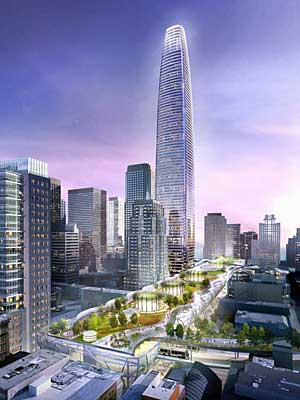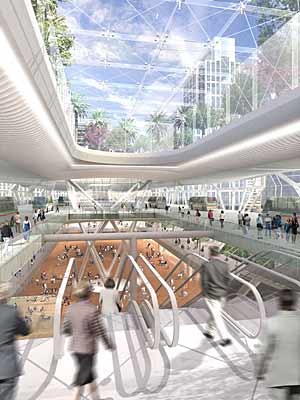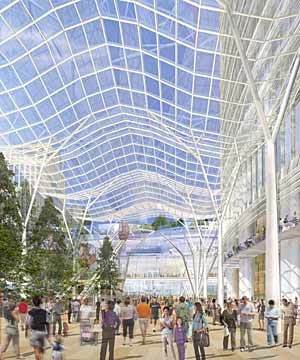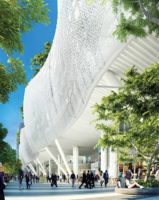Transbay won’t rise as high as his Petronas Towers in Malaysia, but Cesar Pelli and his firm have won the rights to design what could become the tallest tower in San Francisco. Pelli Clarke Pelli Architects, teamed with developer Hines, were awarded exclusive negotiating rights yesterday to a choice site in downtown San Francisco owned by the Transbay Joint Powers Authority (TJPA), which seeks to rebuild the aging Transbay Terminal facility next door.


Pelli’s design is for a 1,200-foot-tall, obelisk-like tower of glass and steel alongside a new terminal for buses and commuter rail. The revamped terminal, which would stretch one-quarter mile and cross above two city streets, will be topped by a 5.4-acre park, designed by Peter Walker and Partners, of Berkeley, California, to emulate several of the state’s varied landscapes.
The Pelli scheme, and Hines’ $350 million bid for the site, triumphed over two rival entries. Skidmore, Owings & Merrill teamed with Rockefeller Group Development in proposing a 1,375-square-foot, torqued tower—narrow at its base, slender and diaphanous at the top—along with a terminal entered through a glassy hall. Rogers Harbour Stirk + Partners worked with SMWM and Forest City Enterprises on a plan that set an airy terminal alongside an Erector-Set-like glass tower topped by an enormous wind turbine.
The competition stirred intense public interest; since early August, when models and design boards were unveiled, the TJPA received nearly 900 public comments. Many people favored SOM’s tower, designed by Brian Lee of the firm’s San Francisco office; the jury that reviewed the proposals for the TJPA called it “memorable and beautiful without seeming too overdone.”
Despite this praise, the jury unanimously recommended the Pelli-Hines proposal to TJPA’s board, which made the final decision. The jury especially liked the park, saying it transformed the rooftop into “a living, breathing, urban organism.” And the low-key high rise, it added, “is timeless and fits in San Francisco.”
The nine-member jury included four architects: Robert Campbell, FAIA, a contributing editor of RECORD; Hsin-Ming Fung, AIA, of Hodgetts + Fung Design and Architecture; Oscar Harris, FAIA, with Turner Associates Architects and Planners; and Allison G. Williams, FAIA, with Perkins+Will.
WRNS Studio, of San Francisco, and Kendall/Heaton, of Houston, will assist Pelli in preparing final designs. The team has much work ahead—starting with the fact that it’s still unclear what sized tower will be allowed on the site, which is currently zoned for 550 feet. San Francisco’s planning department is in the early stages of studying whether or not to allow for taller buildings in the Transbay district, which is south of Market Street in the city’s downtown.





Post a comment to this article
Report Abusive Comment